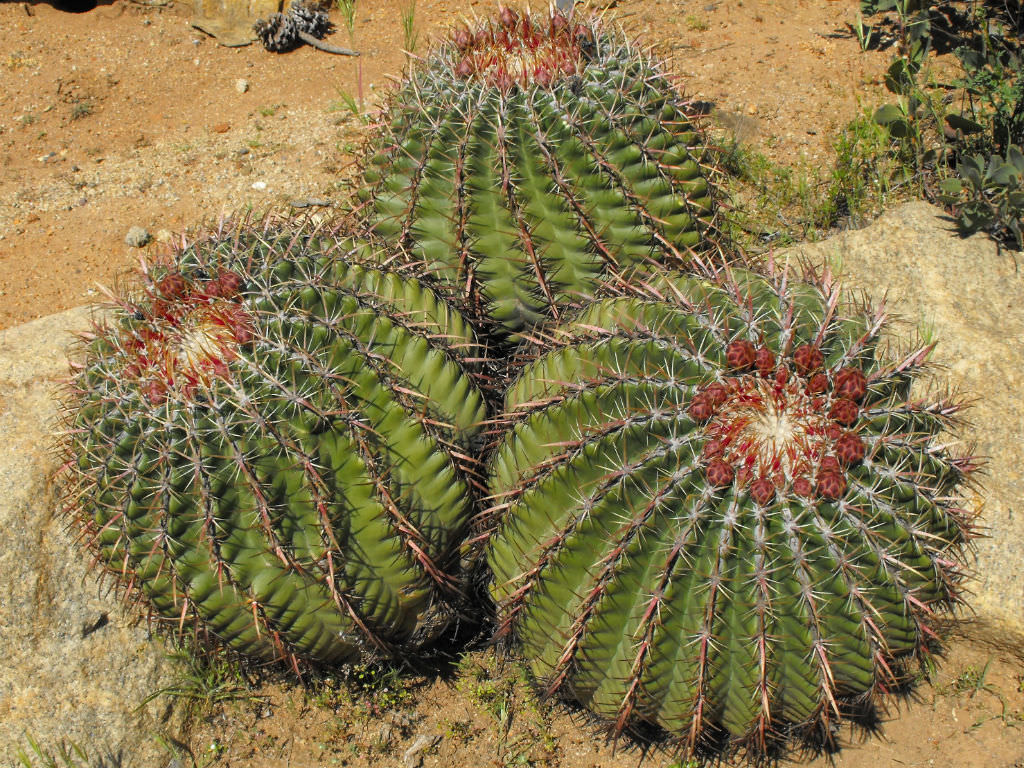Turk's head
(Ferocactus hamatacanthus sinuatus)

Description
Ferocactus hamatacanthus, also known as the "Devil's Tongue Barrel Cactus," is a species of barrel cactus that belongs to the family Cactaceae. This cactus is native to Mexico, where it can be found growing in dry, rocky areas at elevations ranging from 1,000 to 2,500 meters above sea level. In this article, we will explore the characteristics, cultivation, and uses of Ferocactus hamatacanthus. Description Ferocactus hamatacanthus is a large, cylindrical cactus that can grow up to 1 meter tall and 50 cm in diameter. The plant has 20 to 30 prominent ribs that are covered in sharp spines, with the uppermost central spine being hooked and up to 5 cm in length. The cactus produces large, yellow flowers that bloom in the summer and are followed by reddish-brown fruit that contains numerous seeds. Cultivation Ferocactus hamatacanthus is a relatively easy plant to grow and care for, making it a popular choice among cactus enthusiasts. Here are some tips on how to cultivate this plant: Light: This cactus thrives in full sun but can tolerate some shade during the hottest part of the day. Soil: Ferocactus hamatacanthus prefers well-draining soil that is rich in organic matter. A mix of sand, perlite, and peat moss works well. Water: This cactus is drought-tolerant and prefers to be kept on the dry side. Water sparingly and only when the soil is completely dry. Temperature: Ferocactus hamatacanthus can tolerate a wide range of temperatures but prefers to be kept between 15 and 30 degrees Celsius. Propagation Ferocactus hamatacanthus can be propagated from seeds or stem cuttings. Here's how to propagate this plant: Seeds: Sow seeds in a well-draining soil mix and keep moist until germination, which usually takes 2 to 4 weeks. Once the seedlings are large enough to handle, transplant them into individual pots. Stem cuttings: Take a stem cutting from a mature plant and allow the cut end to dry for a few days. Then, plant the cutting in a well-draining soil mix and keep moist until roots develop. Uses Ferocactus hamatacanthus has several uses, both ornamental and medicinal. Here are some of them: Ornamental: Ferocactus hamatacanthus is often grown as an ornamental plant because of its striking appearance. It can be planted in rock gardens, cactus gardens, or in containers. Medicinal: In traditional medicine, Ferocactus hamatacanthus has been used to treat a variety of ailments, including wounds, burns, and inflammation. The cactus contains several bioactive compounds that have been shown to have anti-inflammatory and analgesic properties. Conservation Status According to the International Union for Conservation of Nature (IUCN) Red List of Threatened Species, Ferocactus hamatacanthus is listed as "Least Concern" (LC). This means that the species is not currently considered to be at risk of extinction, although some populations may be declining due to habitat destruction and other threats. However, because Ferocactus hamatacanthus is widely distributed across its range in Mexico and is not currently facing any major threats, it is not considered to be in immediate danger of extinction. Nonetheless, it is important to continue monitoring the status of this species and to take measures to protect it and its habitat in order to ensure its long-term survival. Conclusion Ferocactus hamatacanthus is a fascinating and beautiful cactus that is relatively easy to grow and care for. With its striking appearance and ornamental value, it is a popular choice among cactus enthusiasts. Additionally, its medicinal properties make it a valuable plant in traditional medicine. Whether you're growing Ferocactus hamatacanthus for its beauty or its medicinal benefits, it is sure to provide you with years of enjoyment.
Taxonomic tree:







